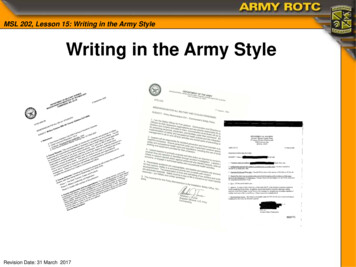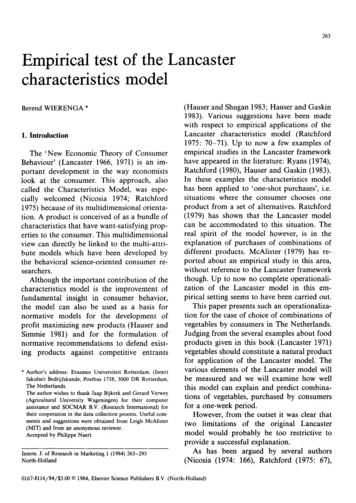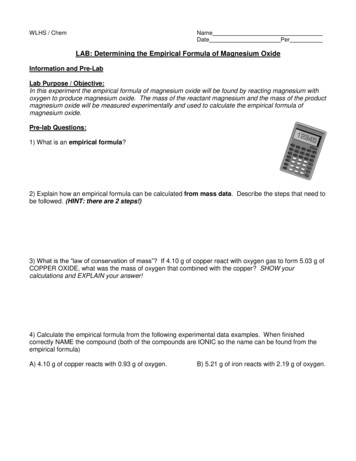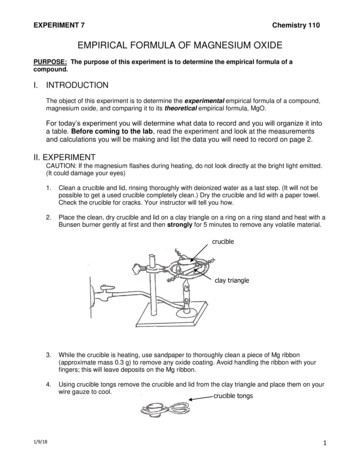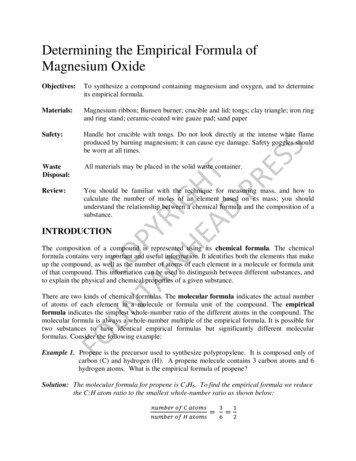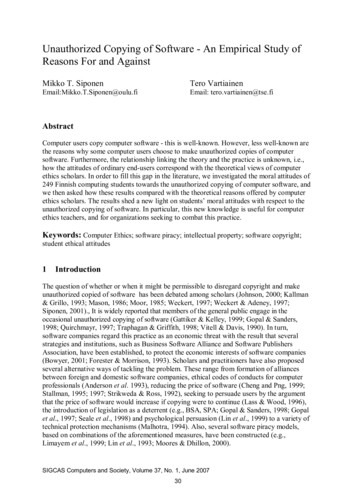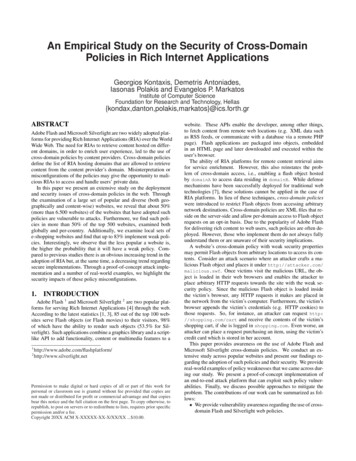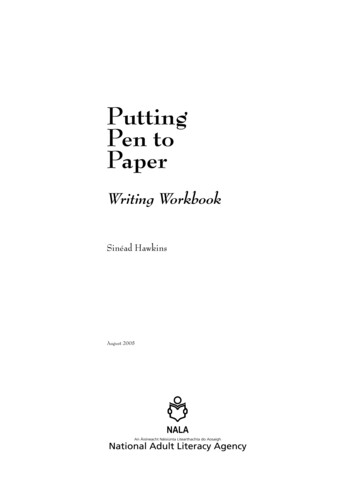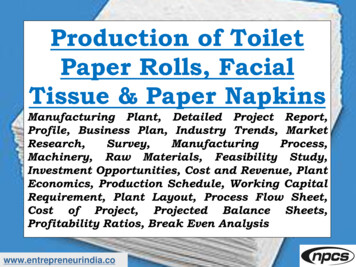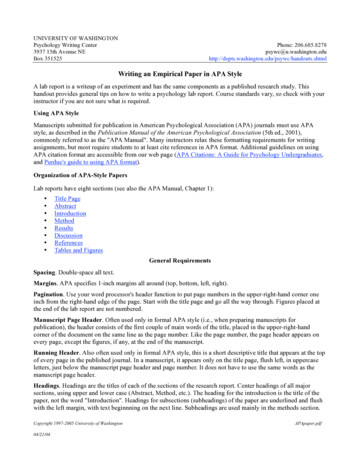
Transcription
UNIVERSITY OF WASHINGTONPsychology Writing Center3937 15th Avenue NEBox 351525Phone: hington.edu/psywc/handouts.shtmlWriting an Empirical Paper in APA StyleA lab report is a writeup of an experiment and has the same components as a published research study. Thishandout provides general tips on how to write a psychology lab report. Course standards vary, so check with yourinstructor if you are not sure what is required.Using APA StyleManuscripts submitted for publication in American Psychological Association (APA) journals must use APAstyle, as described in the Publication Manual of the American Psychological Association (5th ed., 2001),commonly referred to as the "APA Manual". Many instructors relax these formatting requirements for writingassignments, but most require students to at least cite references in APA format. Additional guidelines on usingAPA citation format are accessible from our web page (APA Citations: A Guide for Psychology Undergraduates,and Purdue's guide to using APA format).Organization of APA-Style PapersLab reports have eight sections (see also the APA Manual, Chapter 1): Title erencesTables and FiguresGeneral RequirementsSpacing. Double-space all text.Margins. APA specifies 1-inch margins all around (top, bottom, left, right).Pagination. Use your word processor's header function to put page numbers in the upper-right-hand corner oneinch from the right-hand edge of the page. Start with the title page and go all the way through. Figures placed atthe end of the lab report are not numbered.Manuscript Page Header. Often used only in formal APA style (i.e., when preparing manuscripts forpublication), the header consists of the first couple of main words of the title, placed in the upper-right-handcorner of the document on the same line as the page number. Like the page number, the page header appears onevery page, except the figures, if any, at the end of the manuscript.Running Header. Also often used only in formal APA style, this is a short descriptive title that appears at the topof every page in the published journal. In a manuscript, it appears only on the title page, flush left, in uppercaseletters, just below the manuscript page header and page number. It does not have to use the same words as themanuscript page header.Headings. Headings are the titles of each of the sections of the research report. Center headings of all majorsections, using upper and lower case (Abstract, Method, etc.). The heading for the introduction is the title of thepaper, not the word "Introduction". Headings for subsections (subheadings) of the paper are underlined and flushwith the left margin, with text beginnning on the next line. Subheadings are used mainly in the methods section.Copyright 1997-2005 University of Washington04/21/04APApaper.pdf
For descriptions of how to do further subdivisions, see the APA Manual.Tables and Figures. For student papers, either place these at the end of the paper (formal APA style) orincorporate them into the text; ask your instructor.How To Proceed The hypotheses, methods and results are the easiest to write because they are the most concrete, so you maywant to write these first. The introduction and discussion are often written next. The title and abstract usuallycome last. Make sure that all the sections are well integrated. Start by finding your hypotheses in the introduction andmaking sure that they are clearly stated. Then see whether each hypothesis is addressed, usually in the sameorder, in the Results and Discussion. Pay attention to scientific terminology. Scientific reports don't sound like essays or news stories. They aremore condensed and use more precise language. For example, we cannot "prove" theories in science (we givesupporting evidence or fail to find such evidence). Similarly, avoid adverbs (e.g., "really", "very","surprisingly"); they are not quantitative and therefore add no information. See also our handout, Style Pointsfor Scientific Writing. Check tables and figures (graphs) for accuracy and captions for specificity. Check for spelling and typographical errors. Don't rely only on spell checkers; they often miss errors (e.g.,affect/effect, its/it's). Proofread. Ask at least one other person to read what you have written; they will catch things that you miss.Title PageThe title page announces the title and running head of a lab report or research article. It gives the article title,author name(s), author affiliation, manuscript page header, running head and page number.How to Proceed1. Arrange the title page information on its own page. Center this information from the side margins. Place thetitle a little more than one-third of the way down the page, where the reader's eyes naturally fall.Note: The APA manual says to center the title. This means to center from the sides, not from the top.2. Choose a title thoughtfully (see below). Even if you change it later, a descriptive title will help you to stay ontrack as you write your paper and will convey a good first impression to your readers. Make the title specific.NOT: The Effects of Language Complexity on Mental ProcessingBUT: The Effects of Sentence Complexity on Mental Processing SpeedNOT: Can Stress Predict Memory Accuracy?BUT: Can Stress Level Predict the Accuracy of Eyewitness Accounts? Try to make a statement or ask a question.Categorical Discrimination Begins at BirthCan the Yerkes-Dodson Law Predict Human Performance? Consider including the independent variable (IV) and dependent variable (DV) (and perhaps eventhe outcome if it is straightforward).Copyright 1997-2004, University of Washington04/21/04APApaper.pdf
FORMAT: IV as a Predictor of DVEXAMPLE: Perspective Taking as a Predictor of Marital AdjustmentFORMAT: The Relation between DV and IV is .EXAMPLE: The Relation between Intelligence and Performance Under Stress is Not Inverse Use plain type faceKeep font and font size consistent, and avoid bolding, italics, or underlining in titles.AbstractThink of the abstract as the "Reader's Digest" version of the report. Its purpose is to show the study at a glance.Writing good abstracts requires knowing which information is essential and how to condense it.RequirementsCondensed format. Abstracts must be short (APA Manual: 120 words) yet stand alone. This means that theabstract should be understandable to someone who has not read the study.Order. Arrange information in the same order as the sections in the paper: Introduction, Method, Results, andDiscussion. Each section of the paper requires at least one sentence in the abstract. Methods and Resultsusually require more than one sentence each.Single paragraph. Abstracts are written as one paragraph.How to Proceed1. Write the paper before writing the abstract.2. Look at abstracts from articles in APA journals and use them as models.3. Focus initially on content, not length. It is easier to condense than to expand.4. Look at each section in the paper to determine the main point(s). Underline key sentences or write down thepoint of each paragraph.5. Write a first draft, using the same order as you would for the report:a. Announce the research question (usually one sentence).b. State the purpose of experiment (hypothesis).c. State the method, including number of subjects and what they did. (requirements will vary by instructor.Some instructors want a synopsis in 1-3 sentences; others want more detail.)d. State results (1-3 sentences. Some instructors want p-values. APA does not require them).e. Discuss implications (usually only one sentence).6. Cut out nonessential information. Transitions such as "The results showed." are unnecessary.IntroductionThe goal of the introduction is to justify your study. Introduce the research question, summarize and cite theresearch done to date, and identify a question that has not yet been answered (your study). At the end of theintroduction, state the hypotheses that you tested.RequirementsGive background. This section gives the history behind your research question. Identify the key researchdone in the area so far and the value of your study.Copyright 1997-2004, University of Washington04/21/04APApaper.pdf
Cite all relevant research, not just the studies whose results you agree with. Identify studies that supportcontradictory findings, and suggest what might underlie the differences (look especially at the introductionand discussion sections of the articles you are comparing).State hypotheses and predictions. At the end of the introduction, state the hypothesis that you tested andspecific predictions that follow from it.How to Proceed Find an old review article. Reading a review article or book chapter is an efficient way to start to get anoverview of a new research area. Then, to follow up on the important areas and authors you have identified inthe article, use online search databases to:-Look for later studies by the authors cited in the review article (e.g., PsycInfo).-Find other studies that cite the authors cited in the review article (e.g., SSCI, or Social Science CitationIndex). Make an outline that shows the progression of research that has led to your hypotheses. For each main point, start by citing noncontroversial assumptions of findings. Then discuss areas in whichconflicting results, if any, have emerged. Try to explain the source of the disagreement (e.g., insensitivemeasures, inadequate design, conclusions that went beyond the data or didn't go far enough). At the end of the introduction, identify questions that have not been addressed that led to your hypotheses. Ifthere are more than one or two hypotheses, list them ('This study will test the following hypotheses: (1) . (2). (3) .'). It may be necessary to give a conceptual overview of the experiment here as well, but save thedetails for the Method section. Avoid plagiarism by giving credit where credit is due. Whenever you cite someone else's ideas or use theirlanguage, give the name of the author and the year of publication (see References; APA citations). Using oldreview articles as a starting point for your paper is not plagiarism, but don't present someone else's ideas asthough they were your own. Your paper must, of course, provide your own synthesis of your research. In scientific writing, it is much more common to paraphrase an author's ideas than to use direct quotes (seeAPA citations). If you use direct quotes, however, also cite the page number, like this: "insert quote here"(Abel, 1989, p. 93). Use specific language and support your arguments with concrete examples. Specify referents (e.g., "thisillustrates" should be "this experiment illustrates"). Subjective phrases like "I feel" or "I think" often signalunsupported statements that need to be explained. Don't hesitate to evaluate and critique what you have read. Many novice writers are good at writing detaileddescriptions but balk at evaluating the work of established researchers. Evaluation requires more work andentails more risk, but without it, your paper lacks original synthesis, which falls short of the goal of the paper:to make an original contribution to a research area.MethodThe Method section is a detailed breakdown of the experiment, including your subjects, research design, stimuli,equipment used, and what the subjects actually did (the procedure). Give the reader enough information to be ablereplicate the experiment.RequirementsThe Method section is often divided into subsections, such as Subjects, Design, Stimuli, Equipment, andCopyright 1997-2004, University of Washington04/21/04APApaper.pdf
Procedure. Each subsection should provide only the essential information needed to understand andreasonably replicate the experiment. Very short subsections can be combined (e.g., Stimuli and Equipment).There is no APA rule on the order of subsections. The order shown below is common.How to ProceedSubjects/Participants. State the number of participants (if human) or subjects (if animals), who they were,and how they were selected.ParticipantsWe randomly selected 16 University of Washington students from an introductory psychology course to participate in exchangefor extra credit.SubjectsSubjects were 30 male pigtailed macaques (Macaca nemestrina) bred at the Washington Regional Primate Research CenterBreeding Colony, Medical Lake, Washington. All animals were bred specifically for this project and were shipped to thelaboratory at 3-5 days of age. We randomly assigned subjects to each condition.Materials. This subsection may also be called Stimuli, Equipment, or Apparatus. It briefly describes theequipment/materials used in the experiment.Eye movements were recorded using an NEC model 120 Eyetracker.Design. Identify and explain variables and their levels, and state whether the variables are between groups orwithin subjects.The design was a mixed model with type of information requested, type of emotion, and sex as the between-subjects factors.Heart rate and blood pressure were the within-subjects factors.Procedure. Describe in sequence the procedures used.Subjects were seated at a computer work station. After completing a demographic questionnaire, they received writteninstructions that differed by condition. All subjects were instructed to read a business letter and write a reply. Subjects in themultiple draft condition were told to write an outline of a reply letter before writing a final draft.ResultsThis section presents the statistical analysis of the data collected. It is often less than a page long.RequirementsCondensed format. The Results section is the most condensed and standardized of all the sections in the textof a lab report.No data interpretation. Statistical results are presented but are usually not discussed in this section. Discussresults in the Discussion section.How to Proceed Keep your hypotheses in mind while you write. Each result must refer to a stated hypothesis. Describe all results that are directly related to your research questions or hypotheses. Start with hypothesesyou were able to support with significant statistics before reporting nonsignificant trends. Then describe anyadditional results that are more indirectly relevant to your questions. If you present many results (i.e., many variables or variables with many levels), write a brief summary, thendiscuss each variable in separate subsections. Report main effects before reporting contrasts or interactions. Briefly mention problems such as reasons formissing data, but save discussion of the problems for the discussion section.Copyright 1997-2004, University of Washington04/21/04APApaper.pdf
Use tables and figures to summarize data. Include descriptive statistics (such as means and standarddeviations or standard errors), and give significance levels of any inferential statistics. The goal is to makeyour results section succinct and quantitatively informative, with no extra words (see also our handout, APATable Guidelines). For each test used, provide degrees of freedom, obtained value of the test, and the probability of the resultoccurring by chance (p-value). Here are examples of the results of a t-test and an F-test, respectively: t(23) 101.2, p .001; F(1,3489) 7.943, p .001 (see also our handout Reporting statistical results in APAformat).DiscussionIn this section, interpret your results by relating them to your hypotheses. Use words to explain the quantitativeinformation from the results section.RequirementsDiscuss the results in relation to each hypothesis. This is the most important part of the Discussion section.Discuss possible explanations for your results. This part should follow from the predictions you madeearlier based on possible outcomes of the study. Do the results agree or disagree with the ideas that youintroduced in the Introduction? How do the results relate to previous literature or current theory? Identify anddiscuss limitations in the experimental design that may reduce the strength of your results. Generalize yourresults. This is where you tell the reader the extent to which your study is externally valid. Discuss strengthsand weaknesses of applying your results to, for example, another population, species, age, or sex.Identify followup experiments. Introduce new ideas that your results suggest, and propose ways to test them.How to Proceed Explain whether your results support the hypotheses. Discuss how the results relate to the research question in general.The results are consistent with the Yerkes-Dodson law.These results show the advantage of using a secondary reaction time paradigm for assessing cognitive load during reading.The finding that the infant monkeys increased their food intake in the low-calorie condition and reduced food intake in the highcalorie condition is consistent with the hypothesis that pigtailed macaques adjust their food intake to maintain a constant level ofcaloric intake. Although the difference between the two conditions decreased across time, however, the infants consumed morecalories in the high-calorie condition than the low-calorie condition. If you had a directional hypothesis and your results didn't turn out as expected, discuss possible explanationsas to why, including unanticipated shortcomings in the design, problems such as equipment failure, or eventhat the theory you tested may need modification. Show how your explanation accounts for the specificpattern of results.NOT: One reason for this puzzling result could be that some subjects received different instructions. Another possible reasonmight be that the room was hot. A third possibility is that we should have . . .This example is not well written for two reasons. First, the reasons are unsupported. The author does notexplain how these reasons may have led to the unexpected pattern of results. Second, probably because of thislack of justification, the author's use of "could" and "should" does not sound confident.BETTER: One possible explanation for this result is that experimental subjects received slightly different instructions thancontrol subjects. Subjects in the control condition were told to press [1] for "yes", but subjects in the experimental condition weretold to press [y] for "yes". Because [1] and [y] are positioned apart on the computer keyboard, the extra time required to find [y]Copyright 1997-2004, University of Washington04/21/04APApaper.pdf
may account for the overall longer reaction time in the experimental condition. Another unexpected variable was that theventilation in the room malfunctioned and the room was over 750 F. Although this made the test situation uncomfortable, theroom temperature affected all subjects equally, so we do not regard this extraneous variable as a confound, but it could haveaffected the validity of the results if subjects performed more poorly as a result.Discuss limitations of the experiment that could be remedied in future experiments. State the specific reasonfor performing the next experiment. Do not assume that anything is obvious.Although we controlled the level of subject arousal, we did not control the type of arousal (negative or positive). A future studyin which we assessed the effects of negative versus positive arousal on eyewitness accuracy would enable us to refine YerkesDodson predictions. Avoid overstating the importance of your findings. Be modest rather than expansive. Avoid speculatingbeyond the data. Stay focused on the research question. Resist the urge to digress or to state glittering generalities just becausethis section is the most flexible one. Although you should acknowledge problems or weaknesses of your design, end the paper on a high note.Summarize the study’s strengths, conclusions, implications and/or ideas for future research.ReferencesBelow are the most common citation styles used for writing lab reports (see also pp. 194-221 of the APA Manual,5th ed., and our APA cit
1. Arrange the title page information on its own page. Center this information from the side margins. Place the title a little more than one-third of the way down the page, where the reader's eyes naturally fall. Note: The APA manual says to center the title. This means to center from the si
